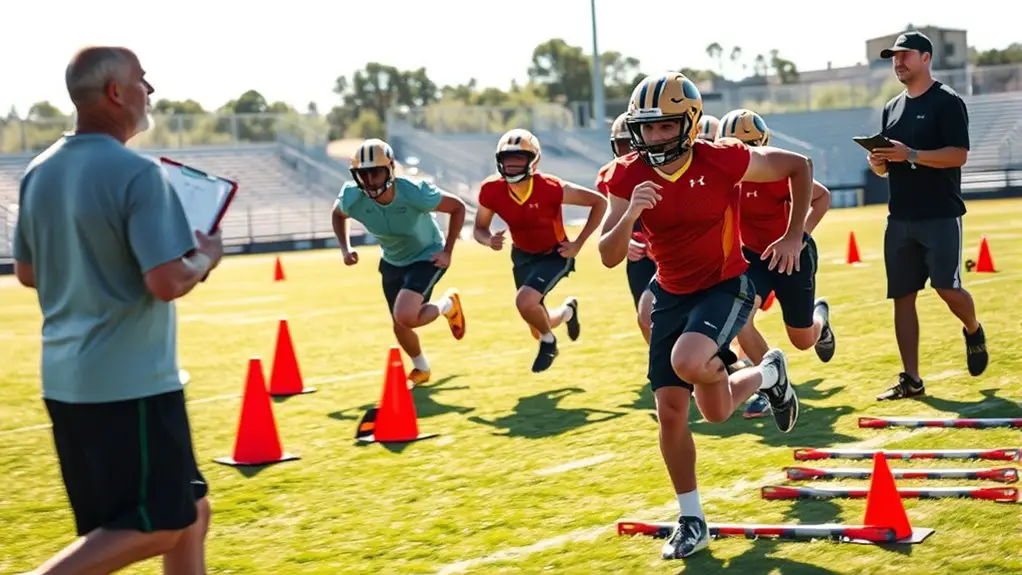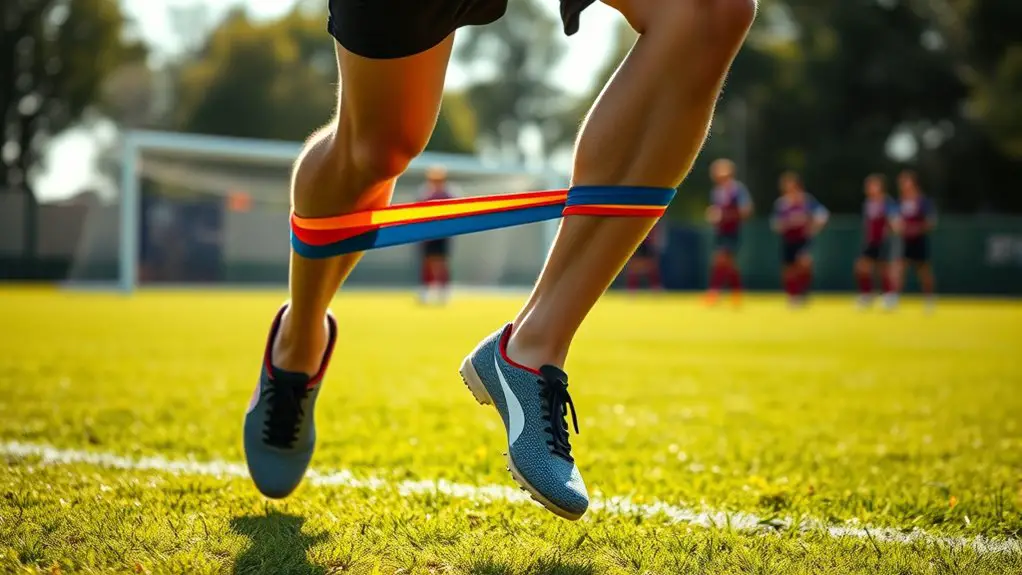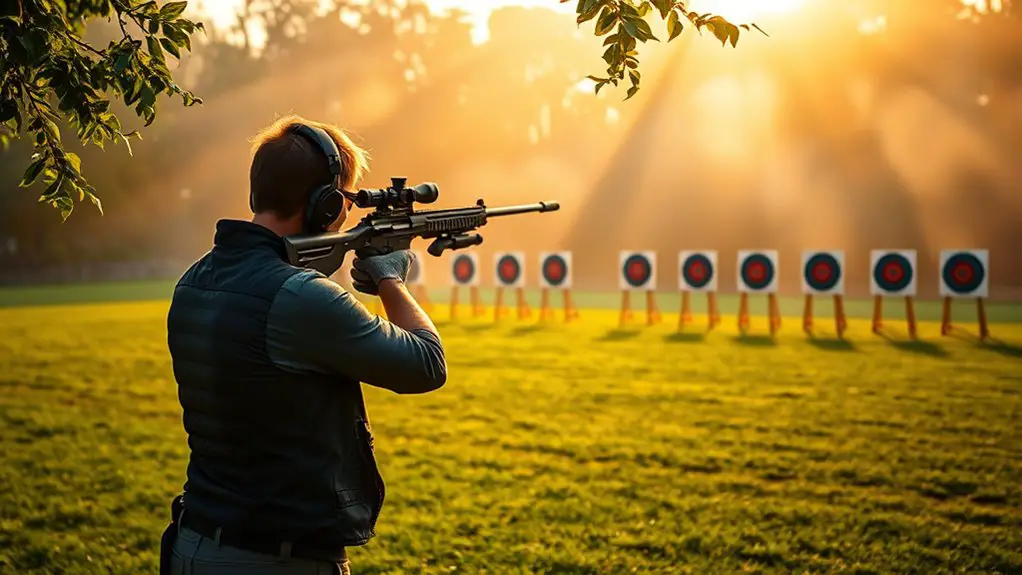To improve your sprint speed as a football player, focus on strength training, agility drills, and proper nutrition. Incorporate exercises like squats and lunges to build power, along with agility drills like ladder and cone workouts to enhance quickness. Don't forget to prioritize hydration and refuel with the right nutrients post-workout. Quality sleep is also critical for recovery. There's plenty more to explore on boosting your speed and performance in football.
Understanding the Importance of Sprint Speed in Football
When you step onto the football field, sprint speed can make a world of difference in your performance. It's not just about how fast you can run; it's about how your sprint mechanics translate into game impact. Each explosive start or quick dash can change the tide of the match. Imagine breaking free from defenders or catching that pass just in time—sprint speed gives you the freedom to make those plays.
Understanding the intricacies of your sprint mechanics helps you maximize your potential. You want to harness every ounce of power, not just for speed, but for agility and precision. The way you position your body, your arm movements, and your foot strikes all play a role. So, as you train, keep in mind that sprint speed isn't just a number; it's your ticket to outmaneuvering opponents and making those game-changing moments happen. Additionally, incorporating interval training into your regimen can significantly enhance your endurance and speed capabilities.
Key Techniques to Enhance Sprint Speed
Improving your sprint speed involves more than just running faster; it requires specific techniques that can fine-tune your mechanics and boost your performance on the field. Focusing on stride mechanics is essential. By maximizing your stride length and frequency, you'll cover more ground with each step. Incorporating resistance training can also enhance your power output, making each sprint more explosive. Additionally, including plyometric exercises in your routine can significantly improve your explosiveness and overall sprinting capability.
| Technique | Benefit |
|---|---|
| Stride Mechanics | Increases speed efficiency |
| Resistance Training | Builds explosive power |
| Core Stability | Improves overall balance |
| Flexibility Work | Enhances stride length |
Embrace these techniques, and you'll not only feel the freedom of speed but also the thrill of breaking through barriers. Remember, every detail matters when it comes to sprinting; fine-tune your approach and watch your performance soar.
Strength Training Exercises for Acceleration
To boost your acceleration on the field, incorporating specific strength training exercises is essential. Focus on compound movements like squats and deadlifts to build the foundational strength needed for explosive power. These exercises engage multiple muscle groups, enhancing your overall athleticism.
Don't overlook plyometrics, such as box jumps and power cleans; they're fantastic for developing fast-twitch muscle fibers, which directly contribute to quicker starts. Lunges, especially when performed with weights, can also improve your leg drive and stability.
Additionally, consider incorporating resistance sprints. By using a sled or parachute, you can add extra resistance, forcing your muscles to adapt and grow stronger. This targeted approach not only boosts your acceleration but also helps in maintaining speed during longer plays. Remember, it's about building strength while ensuring your movements mimic the demands of the game. So, embrace these exercises to release your full potential on the field! Proper technique is vital for maximizing your explosive power and minimizing injury risk.
Agility Drills to Improve Quickness
To boost your quickness on the field, incorporating agility drills into your routine is essential. Ladder drills can enhance your foot speed, while cone drills improve your ability to change direction swiftly. Don't forget about plyometric exercises, which offer significant benefits for explosive movement. Consistency in practice leads to significant improvements in athletic performance.
Ladder Drills for Speed
Ladder drills can elevate your sprint speed and overall agility, making them essential for football players. By incorporating ladder variations into your training, you'll boost your coordination and quickness. Here are four engaging drills to try:
- In and Out: Step quickly in and out of each rung, focusing on foot placement.
- Lateral Shuffle: Move side to side, ensuring both feet touch each square for balance.
- Single-Leg Hops: Jump on one leg through the ladder, enhancing stability and strength.
- Carioca: Face sideways as you weave in and out, improving hip mobility and coordination.
These coordination drills not only sharpen your skills but also give you the freedom to move fluidly on the field. Enjoy the rhythm!
Cone Drills for Agility
While ladder drills enhance your footwork, cone drills are equally essential for developing agility on the field. These drills improve your quickness and help you navigate the game with finesse. By practicing different cone formations, you can adapt to various game situations. Here are some effective drill variations:
| Drill Variation | Description |
|---|---|
| Zig-Zag Sprint | Sprint through cones in a zig-zag pattern. |
| T-Drill | Sprint forward, side shuffle, and backpedal around cones. |
| Box Drill | Run around cones in a square pattern, focusing on sharp turns. |
| Figure Eight | Weave through two cones placed close together. |
Incorporating these cone drills into your training routine will boost your agility and overall performance on the field.
Plyometric Exercises Benefits
Plyometric exercises can greatly enhance your quickness, making them an essential part of any football training regimen. These exercises focus on explosive power, allowing you to release your speed on the field. Here are some key plyometric benefits:
- Increased Muscle Strength: Boost your overall muscle capacity, giving you more power with every sprint.
- Improved Coordination: Develop better body control, helping you maneuver around opponents effortlessly.
- Enhanced Reaction Time: Train your muscles to respond quickly, allowing for faster movements when the game heats up.
- Boosted Endurance: Build stamina, letting you maintain high speeds throughout the match.
Incorporating these drills into your routine will set you free to dominate the game with unmatched quickness and agility!
Proper Warm-Up and Cool-Down Routines
A proper warm-up and cool-down routine is essential for football players looking to enhance their sprint speed and prevent injuries. Before hitting the field, you should engage in dynamic stretching to prepare your muscles and joints. This helps increase blood flow and flexibility, allowing for explosive movements during your sprints. Try leg swings, high knees, and butt kicks to get your body ready to perform at its best. Incorporating dynamic stretching into your routine not only prepares your muscles but also activates the nervous system for improved performance.
After your training or game, don't skip the cool-down. It's vital for post workout recovery. Spend a few minutes doing static stretches to help your muscles relax and reduce soreness. Focus on the major muscle groups you've used, such as your hamstrings, quads, and calves. Remember, taking time for both warm-up and cool-down routines not only boosts your sprint speed but also keeps you in the game longer, giving you the freedom to play without the fear of injury.
Nutrition and Recovery Strategies for Optimal Performance
After you've warmed up and cooled down properly, focusing on nutrition and recovery can greatly enhance your sprint speed and overall performance on the field. Here are four key strategies to contemplate:
- Meal Timing: Fuel your body with a balanced meal 2-3 hours before practice, emphasizing carbs and proteins for sustained energy.
- Hydration Strategies: Stay ahead of dehydration by drinking water throughout the day and contemplate electrolyte drinks post-workout to replenish lost minerals. Proper hydration is crucial for optimal performance.
- Post-Workout Nutrition: Refuel within 30 minutes after training with a protein-rich snack to kickstart recovery and muscle repair.
- Sleep: Prioritize quality sleep—aim for 7-9 hours nightly—to allow your body to recover and rebuild, ensuring you're ready to hit the field again.
Frequently Asked Questions
How Does Sprinting Technique Differ for Various Football Positions?
Sprinting technique varies greatly across football positions. For you as a wide receiver, focusing on acceleration mechanics is essential for quick bursts, while linemen might prioritize power and explosive starts. Position-specific techniques, like maintaining a low center of gravity for agility or utilizing longer strides for speed, play an important role. By understanding these differences, you can tailor your training to enhance your effectiveness on the field and embrace your unique playing style.
What Role Does Footwear Play in Sprint Performance?
Footwear plays a vital role in your sprint performance. The right shoe materials can enhance comfort and reduce weight, allowing you to move more freely. A well-designed traction pattern provides the grip you need to accelerate quickly without slipping. When you're sprinting, it's essential that your shoes support your foot while maximizing power transfer. So, investing in quality footwear tailored to your needs can make all the difference in your speed on the field.
How Often Should Sprint Training Be Incorporated Into Practice?
When it comes to sprint training, you'll want to find a balance that suits your goals and needs. Incorporating sprint frequency into your practice two to three times a week can help you develop speed without overtraining. Listen to your body and adjust accordingly; it's all about that freedom to explore your limits. Keep your sessions varied and fun, ensuring you're enjoying the process while getting faster on the field.
Can Sprinting Help Reduce the Risk of Injuries?
Yes, sprinting can definitely help reduce the risk of injuries. By focusing on proper sprint mechanics, you're not only enhancing your speed but also strengthening muscles and improving flexibility, which are essential for injury prevention. When you train your body to move efficiently, it learns to absorb impact better and maintain balance during high-intensity play. So, incorporating sprinting into your routine can give you the freedom to play without the constant worry of injuries.
What Mental Strategies Improve Sprint Performance During Games?
Think of your mind as a powerful engine, driving your performance on the field. To boost your sprinting, embrace visualization techniques—picture yourself gliding past defenders with effortless speed. Pair this with focus strategies to keep distractions at bay. When you feel the pressure, remind yourself of your training and the freedom it brings. Harnessing these mental tools not only elevates your performance but also releases your true potential during the game.




